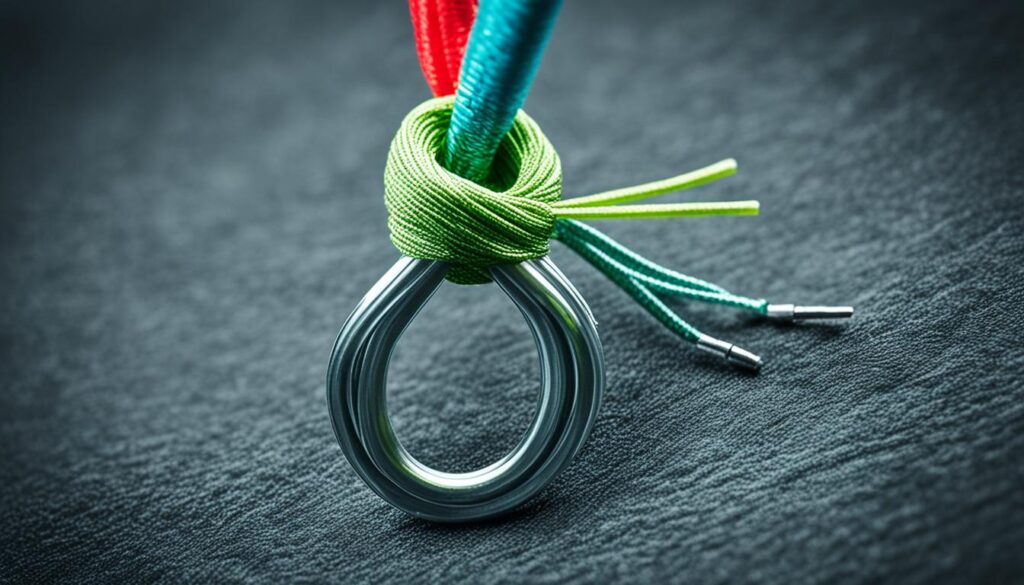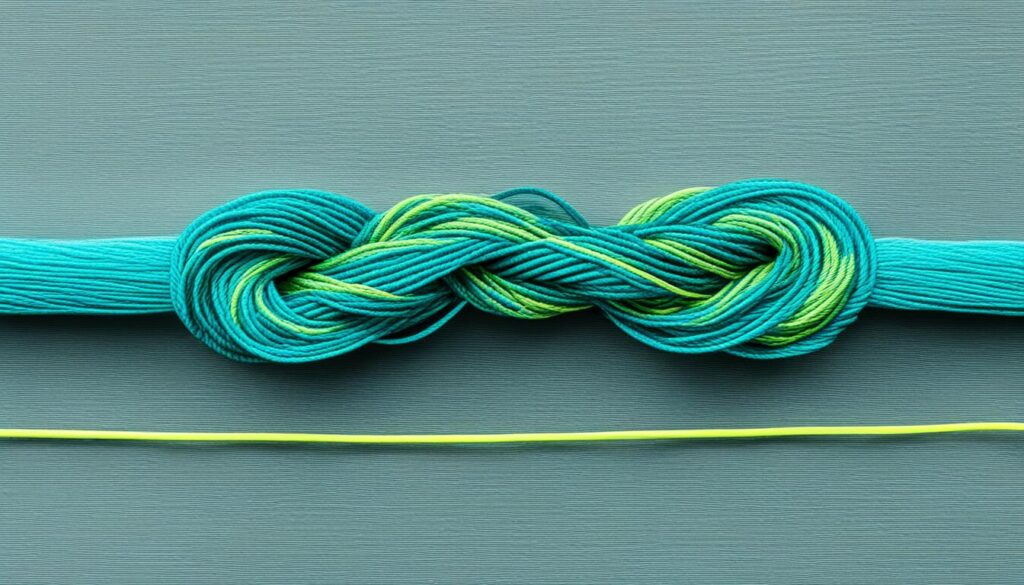Welcome, anglers! Want to up your fishing game? Knowing how to tie a Clinch Knot is critical. This knot is easy to learn but challenging. It keeps your fishing line safe on your hook or lure.
Our guide is for everyone, whether you’re just starting or have fished for years. With clear steps, we’ll show you how to tie a Clinch Knot. Let’s dive in and learn this crucial skill together!
Mastering the Clinch Knot Technique
To tie the Clinch Knot well, follow these steps. First, put the line through the hook’s eye.
- Start by passing the line through the eye of the hook or lure.
- Wrap the tag end of the line around the main line at least 5 times, preferably 7 times.
- Take the tag end and pass it through the small opening in the line under the first wrap near the eye of the hook.
- Bring the tag end back up through the loop that is now formed at the top of the knot.
- Wet the line and slowly pull the tag end tight to cinch the knot down.
Best Practices for Tying the Clinch Knot
When you tie the Clinch Knot, here’s how to do it best for strength and reliability:
- Moisten the line before cinching the knot to reduce friction and allow for a tighter tie.
- Always make at least five wraps around the main line for maximum strength, but preferably seven wraps for added security.
- Pass the tag end of the line through the small opening created by the wraps near the eye of the hook for a secure hold.
- Slowly tighten the knot by pulling the tag end while holding the main line, ensuring the wraps are neatly aligned.
- After tightening the knot, trim any excess line close to the knot for a clean finish.
The Importance of a Good Knot
A good knot is key in fishing for two big reasons. First, it keeps your catch from getting away. This is because it secures the hook or lure to the line well. When a knot isn’t tied right, your fish might escape. Second, it keeps the fishing line strong. A good knot stops the line from breaking easily, especially with a big fish pulling on it. Tying good knots helps you catch more fish and securely connect your line.
“A good knot can mean the difference between landing a trophy fish and losing it. Take the time to learn proper knot tying techniques, and you’ll improve your success on the water.” – Fishing Pro
The Basics of Knot Tying
Knot tying is essential for anglers. It means learning different methods and tying the right knot for each fishing need. Begin with simple knots like the Clinch Knot. Then, learn more complicated knots. Tying knots with various lines and in different ways will make you better. Getting good at the Clinch Knot improves your fishing. Use tips for tying it well to make your knots strong.
Why Knot Tying Matters
A good knot is vital in fishing. It keeps your hook or lure on the line safely. This lowers the chance of losing your catch. Also, a tight knot keeps your line strong, stopping it from fraying.
| Knot | Advantages |
|---|---|
| Palomar Knot | Simple, strong, and versatile |
| Loop Knot | Enhances bait movement |
| Slip Knot | Easy to tie and adjust |
Learning and practicing good knot tying techniques is essential for any angler who wants to improve their chances of success on the water.

The Palomar Knot
The Palomar Knot is a must-know for all fishermen. It’s simple, strong, and works in many fishing situations. Here’s how to tie it:
- First, fold about 6 inches of your line and push it through the hook’s eye.
- Next, make a loose overhand knot with the hook at the bottom.
- Now, hold the overhand knot with your thumb and forefinger. Pull the loop over the hook and, then, over the eye.
- Finally, pull both ends of the line to tighten the knot. Make sure the knot is snug against the hook’s eye.

The Loop Knot
The Loop Knot helps anglers a lot. It makes bait or lures move better, which attracts fish. It’s a favorite among fishers for these reasons.
Here’s a simple guide to tie the Loop Knot:
- Make an overhand knot at the end of your line.
- Put the tag end through the hook or lure’s eye.
- Thread the tag end back through the first knot.
- Adjust the loop size by pulling both ends.
- Wrap the tag end around the line two times.
- Thread the tag end through the overhand knot again.
- Wet the knot and pull both ends to tighten.
Adding the Loop Knot to your fishing skills is smart. It improves bait movement and draws in more fish. Every angler should know and use this knot.
Benefits of using a Loop Knot in fishing
The Loop Knot has many pluses for fishing:
- Enhanced bait movement: It makes bait or lures look alive, attracting more fish. This leads to more chances to catch them.
- More natural presentation: With it, your bait acts natural. It fools fish into biting.
- Increased hook-up ratio: Bait moves freely, making it hard for fish to see the hook. This means more catches.
- Versatility: Use it with various baits and methods, from soft plastics to live baits. It makes everything better.
The Slip Knot
The Slip Knot is both simple and effective. It is a favorite among fishing fans because it’s easy to change and use.
Here’s how to make a Slip Knot:
- Start by making a loop at the end of your fishing line.
- Next, put the end of the line through the loop.
- Pull the loop tight around the item you want to attach to finish. This could be a hook or a lure.
- Make the loop bigger or smaller as you need.
| Benefits of using a Slip Knot in fishing |
|---|
| Allows for easy attachment and adjustment of bait or lures |
| Simple and quick to tie and untie |
| Securely holds bait or lures in place |
| Offers versatility for different fishing scenarios |
Troubleshooting Common Problems with Fishing Knots
Even skilled fishermen may run into issues with their knots. Thankfully, you can troubleshoot and avoid these common problems. Below are some helpful tips to ensure your knots stay strong and last longer:
- Use the right knot for the situation and type of line. Every fishing situation needs a specific knot. Select the correct one for your line and scenario. It guarantees a strong link between your line and your bait or lure.
- Lubricate your line before tying the knot to reduce friction. Friction can make your knot weak and fail. Put water or saliva on your line before you tie it. This reduces friction, making your knot tighter and more secure.
- Pull the knot tight before securing it to ensure it won’t come undone. After knotting, make sure to pull it tight. This removes slack, preventing it from coming loose while fishing. Being patient and checking the knot’s tightness is crucial.
- Could you check the integrity of your knots regularly and retake them if necessary? You should frequently check your knots for any wear or damage. If a knot looks frayed or loose, redo it. Regular knot checks and fixes keep your gear working well.
Conclusion
Learning how to tie fishing knots well is vital for any angler. It can make a big difference in your fishing success. You should know the Clinch knot, Palomar knot Loop, and Slip knots. These knots help keep your catch on, protect your line, and make your bait move better.
When you know these knots, you become better at all kinds of fishing. They help catch big fish or enjoy a day by the lake. How you tie your line matters in fishing. It makes a big difference in how well you catch fish.
You can take the time to learn and get good at tying these knots. You’ll catch more fish and have better fishing trips. Knot tying is vital in fishing. It creates a strong link between you and the fish. This link can give you an advantage over the fish you’re trying to catch.
FAQ
How do I tie the Clinch Knot?
Tying a Clinch Knot is easy. First, pass the line through the hook’s eye. then wrap the line around itself 5 to 7 times. Next, thread the line through the first loop near the hook’s eye.
After that, put the tag end through the new loop at the top of the knot. Wet the line and pull the tag end to tighten.
Why is knot tying important in fishing?
Knot tying is key in fishing for two big reasons. It keeps your hook or lure on, reducing lost catches. Also, it keeps your line strong, which is vital when fighting big fish.
What are some tips for tying the Clinch Knot?
For a good Clinch Knot, use the right line and knot. Lubricate the line to ease the pull. Make sure it’s tight. And, always check your knots to keep them strong.
How do I tie the Palomar Knot?
To do the Palomar Knot, start by making a loop in the line. Put the loop through the hook’s eye. Then do a simple overhand knot. Finally, pull the two ends to secure the knot tightly.
What are the benefits of using a Loop Knot in fishing?
The Loop Knot makes your bait or lure move better in the water. It makes your fishing more appealing to fish. So, it’s a great knot to know as an angler.
How do I tie a Slip Knot?
To tie a Slip Knot, begin by making a loop in the line. Then, pass the line’s end through the loop. Finally, tighten the knot around your hook or lure. Adjust the loop’s size as needed.
What are some tips for keeping fishing knots in good condition?
To keep your knots strong, use the right type for your line. Grease the line to lessen wear. Always make sure the knot is tight. Check and redo knots as needed.
Why is mastering fishing knots important?
Knowing how to tie fishing knots is crucial for a successful angler. It helps secure your catch, keep your line whole, and lure fish effectively.
How important is knot tying in fishing?
Learning how to tie knots is vital for all anglers. It means you’re ready for any fishing situation. With the right knots, you can fish more successfully.
